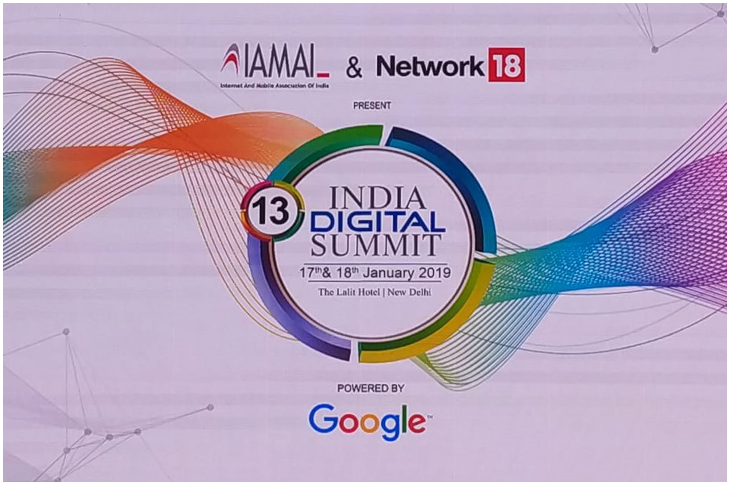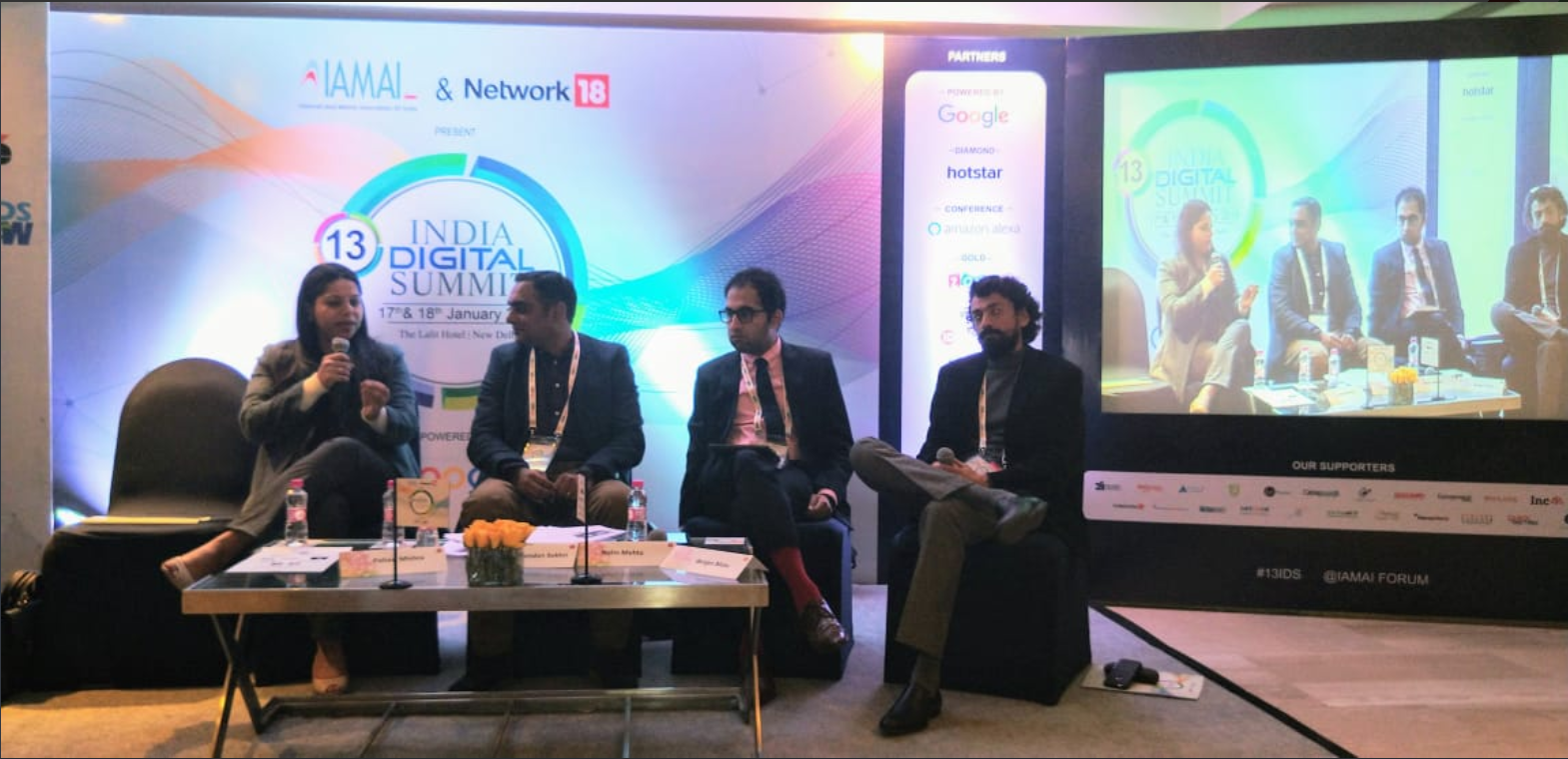IAMAI India Digital Summit – Session on tackling fake news

Scatter is covering the 13th edition of IAMAI’s India Digital Summit being held at the LaLit. This is the second of the reports that will be flowing in. Watch this space for more.
13th India Digital Summit
17th January; Day 1
Hall 3: News & Media
Session 3: Chaffing Fact from Fiction: Tackling Fake News
Fake news. Two words that have taken digital inhabitants and consumers by storm.
With countless discussions around the subject already, one might wonder how this one came to stand out.
Well, for starters, it was being moderated by Nalin Mehta, Executive Editor for TOI Online. And the panel comprised the biggies of the publishing industry – Berges Y Malu, Head of Public Policy and Corporate Affairs at Sharechat; Pallavi Mishra, Content Policy Head at Vishvanews.com; and Abhinandan Sekhri, Founder and CEO of Newslaundry.

(source)
The panel discussion began with what could be considered basic, yet remains a concept that stumps many of us – the difference between bad reporting and fake news.
Nalin emphasised how fake news is produced knowingly and with the intention to deceive. Which implies it certainly doesn’t cover news that you disagree with. Because to label anything that contradicts your views as fake news can be dangerous and undeservedly discredit valuable information.
This effort to break down the concept of fake news was followed by a reflection upon its source.
Coming from a company that specialises in fact-checking, Pallavi highlighted how with any content that circulates on the multi-platformed world of today, fake news can’t be attributed to any one party.
Sure, the media is one of the players contributing to this phenomenon. But two other parties that add significantly to this wave are people making money off clickbait and those looking to further their propaganda.
Berges opined that finding out who’s creating and promoting fake news is a mammoth task. Because, in India, the creation and distribution of fake news is not money-driven. It is done with an intention to deceive and misinform.
Nalin then took the discussion further, asking how platforms deal with messaging that draws sensational connections.
Berges responded by making clear his opinion about the role platforms play: “Platforms don’t kill people. People kill people. Platforms don’t spread fake news; people do.” He went on to explain that the quality of content on a platform is also greatly influenced by the users who make up that ecosystem.
Moreover, as for their position as a platform, they can take down content that incites violence. However, as per the laws, they are not meant to streamline the flow of content. As long as it meets the community guidelines, content can’t be taken down.
Abhinandan countered this view by pointing out that platforms may not spread fake news but they surely do enable people. Besides, he pointed out, it is not an irrational expectation to have platforms take down potentially harmful data.
As the discussion went back and forth, Nalin added his views, saying that a platform can’t be blamed entirely. Because doing so amounts to throwing the baby out with the bathwater. He added that there isn’t a right answer to the effort of curbing the distribution of fake news.
As to whether content flow should be regulated to prevent the sharing of fake news, Berges said that while regulations should be put in place, people also shouldn’t have unfair expectations. For instance, one can’t desire regulations tailored to personal expectations.
The discussion then shifted to the challenges faced when sieving out fake news on a daily basis. Pallavi responded by saying “the biggest challenge is WhatsApp”. However, even there things have improved.
Where initially the resources to get to fake news were limited, today the flow of information is being increasingly directed to fact-checking companies. Now even consumers are becoming increasingly keen to share more accurate content with their contacts.
This immediately led Nalin to wonder if WhatsApp births more fake news because of the anonymity it offers to those who start circulating it.
While anonymity is definitely a factor, Pallavi assured the panel that the source of fake news can often be found. But in most cases, it is perpetrated months in advance. So catching it becomes a viable option only after the piece of content becomes widespread.
Berges offered a solution to the problem: his platform registers users only after they provide personal details, such as phone numbers. This makes it far easier to catch users who spread fake news.
As for adopting methods of preventing the flow of fake news, Abhinandan provided a more behaviour-based insight, saying that people’s approach towards furthering objectionable content or an opinion online is very different from their attitude in real life.
For instance, as part of what is now being termed as ‘online disinhibition syndrome’, people feel emboldened to voice objectionable opinions online that they wouldn’t do face-to-face.
Therefore, models of regulations can’t be replicated from country to country.
As the session neared its closing, the panel discussion gave way to a question-and-answer round with the audience. Questions were directed more at the methods and approaches adopted by the speakers’ companies than at the general state of the digital world.
Pallavi was asked if Vishvasnews is affected by the motivations of its patrons. Or if it looks to counter any external ideological waves. She assured the audience member of Vishvasnews’ desire to only bust fake news and not ‘counter’ any content in the market.
With regard to his context and experience, Nalin added that fact-check teams are set up in separation from the newsroom. This is to ensure that the editor’s opinion doesn’t affect that flow of information.
Abhinandan was asked how Newslaundry tackles contemporary news channels that cater to more traditional audiences (and often also further hate).
He responded by saying that while he isn’t a fan of those channels, one can’t do anything to fight media-birthed hate. Because, after all, it is not fake news. Moreover, anger, hate, fear, and lust are all easily triggered emotions. So platforms that utilise those fall in a different category.
Having run out of time tackling an issue that’s tough to find a conclusive answer for, the session wrapped up with cameras flashing at the panellists, as the audience rushed forward with extended hands and business cards ready.
Did you happen to catch the session on viral content? If not, click here to get all the meaty bits.
